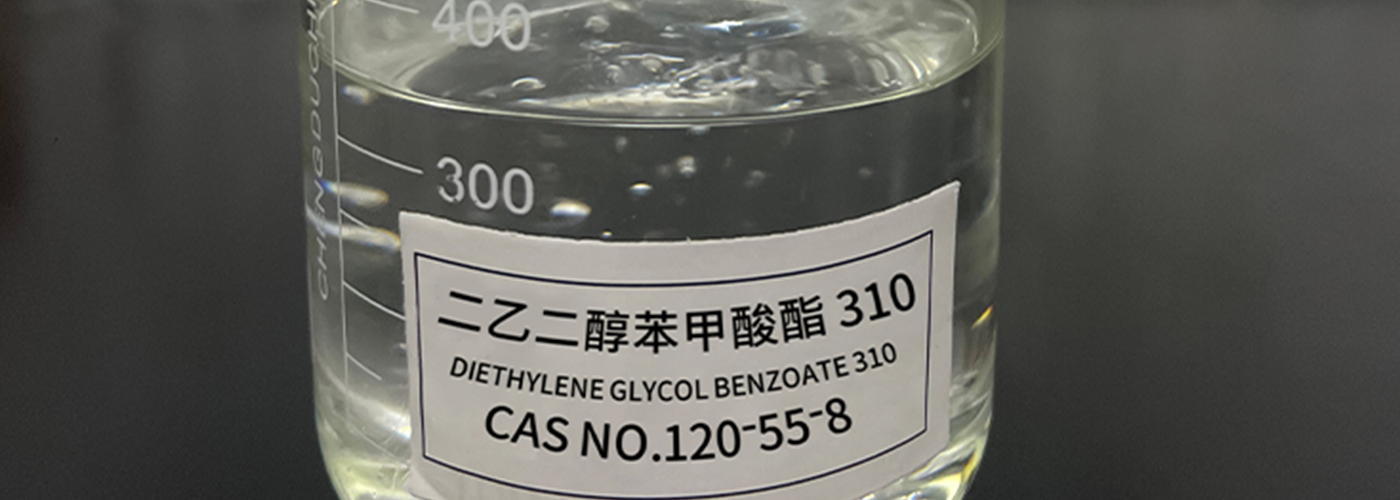
Performance characteristics
Appearance and state: Diethylene glycol dibenzoate (DEDB) is a colorless or light yellow transparent oily liquid with no mechanical impurities. This liquid state makes it have good fluidity and easy to operate in various processing and application processes.
Density and boiling point: Its density is relatively large, about 1.174 – 1.184 g/cm³, and its boiling point is relatively high, at about 236℃ (1.33kPa). The higher boiling point allows it to remain stable and not easily volatilize in some high-temperature processing processes, reducing the losses caused by volatilization and pollution to the environment.
Solubility: It has good solubility and can be dissolved in a variety of resins such as polyvinyl chloride (PVC), vinyl chloride-vinyl acetate copolymer (EVA), polystyrene (PS), etc. This solubility allows it to be well integrated into the polymer system and exert its performance. At the same time, it can also be dissolved in many organic solvents, such as ethanol, acetone, etc., but its solubility in water is poor.
Good stability: At room temperature, it is not easy to react chemically with other substances. Under the condition of heating and the presence of appropriate catalysts, it can participate in some ester exchange reactions, which provides the possibility of its application in chemical synthesis and material modification.
Reactivity: The ester group in the molecule can be used as a reaction site. Under some specific chemical reaction conditions, such as reacting with compounds containing hydroxyl or amino groups, it can be modified, thereby expanding its application range.
Weather resistance and water resistance: DEDB has certain weather resistance and can resist the influence of external environmental factors such as ultraviolet rays and oxygen on material properties, so that the materials containing it can maintain good performance when used outdoors. At the same time, it also has good water resistance, which can prevent the material from degrading due to water absorption in a humid environment.
Application field
Plastic industry polyvinyl chloride (PVC) products: It is a widely used plasticizer in PVC products. It plays an important role in PVC soft products such as PVC film, PVC pipe, PVC artificial leather, etc. For example, in PVC film, adding DEDB can increase the flexibility, tensile strength and transparency of the film. It can effectively reduce the force between PVC molecular chains, making PVC molecular chains easier to slide, thereby making the film softer without excessively reducing the strength of the material. In PVC pipes, DEDB can improve the toughness and low temperature resistance of the pipes, making the pipes less likely to break in cold environments.
Rubber industry Synthetic rubber and natural rubber products: As a rubber processing aid, it is used to improve the processing performance and physical properties of rubber. In the rubber mixing process, DEDB can promote the mixing of rubber and other compounding agents and reduce the energy consumption in the mixing process. In vulcanized rubber products, it can improve the elasticity, wear resistance and aging resistance of rubber. For example, in the production of automobile tires, DEDB can make the tire rubber better resist wear and aging during driving and extend the service life of the tires.
Paints and inks field Paints: In paints, DEDB can be used as a film-forming aid. It can improve the film-forming properties of the paint, so that the paint forms a more uniform and smooth paint film during the drying process. At the same time, it can also improve the flexibility and adhesion of the paint, so that the paint can better adhere to various substrates, such as metal, wood, plastic, etc. In some paints that need to be used outdoors for a long time, the weather resistance of DEDB helps to maintain the color and gloss of the paint film. Used in ink formulations, it can improve the fluidity and transferability of inks, so that the ink can be better transferred from the printing plate to the printing material during the printing process. And it can also increase the drying speed and glossiness of the ink, and enhance the quality of the printed product.
Application method
Direct addition method: In the plastics industry, DEDB is usually added directly during the processing of resins such as PVC. Generally, PVC resin powder and DEDB are mixed in a high-speed mixer in a certain ratio (such as 100:30-100:60, the specific ratio depends on the product requirements). When mixing, first add the PVC resin powder to the mixer, start stirring, and then slowly add DEDB to ensure uniform mixing. The mixing time is generally about 5-15 minutes, and the mixing temperature is controlled at 80-100℃. This method allows DEDB to fully contact with the resin particles and better play a plasticizing role in subsequent processing (such as extrusion, injection molding, etc.).
Premixing method: In the field of coatings and inks, DEDB can be premixed with some solvents or resins. For example, in the production of coatings, DEDB, alkyd resin and some organic solvents (such as toluene) are placed in a reactor in a certain proportion and premixed at an appropriate temperature (such as 40-60°C) and stirring speed. The premixing time can be about 30 minutes to 2 hours, so that DEDB can be better dissolved in the system to form a uniform premixed liquid. The premixed liquid is then mixed with other coating ingredients (such as pigments, fillers, etc.) to prepare the final coating product. This method helps to improve the dispersibility of DEDB in the coating or ink system, so as to better exert its performance.

